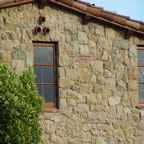In California, the Santa Barbara region provides an unusual selection of geological landforms, stone formations, and other features that include rocks more than 50 million years old. Because of this, Santa Barbara Sandstone is native to Southern California and naturally captures the iconic warm glow of the areas sun-baked Riviera
During the last half million years the earths movement included faulting and uplifting that produced the Santa Ynez Mountain Range as well as other formations along the coast. And during this time the sea level was rising and falling, enveloping the entire Santa Barbara area about every 20,000 years.
This pressure of water and sand/rock created the marine layer known as Eocene, which is the geological layer that is visible both above and below the surface. This sandstone rock deposit was formed by the accumulation of sediments of small grains such as quartz and is what produces the unique and beautiful natural stone.
Santa Barbara sandstone is not ‘quarried’, but rather ‘harvested’, as boulders. The stone is popular with masons, as it is fabricated by hand or machine with ease. The colors and textures of SBS are predominantly a unique golden color with variations available in hues from tans to light green. Architects specify Santa Barbara sandstone “rubble” to re-create the look of Old-World, Tuscany, French Country and Spanish Colonial architecture and it remains popular and recognizable on many prominent public buildings and residences in Southern California.
Shown here are some of the varieties of stone styles available with this stone such as; rubble, five point, full and thin veneers.
An important benefit, the use of Santa Barbara sandstone offers LEED points for materials and resources located within 500 miles of this area.

